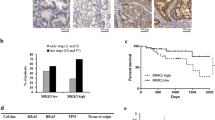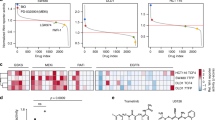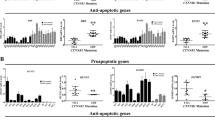Abstract
The RAF–mitogen-activated protein kinase kinase 1/2–extracellular signal-regulated kinase 1/2 (RAF–MEK1/2–ERK1/2) pathway is activated in many human tumours and can protect cells against growth factor deprivation; however, most such studies have relied upon overexpression of RAF or MEK constructs that are not found in tumours. Here we show that expression of the endogenous BRAFV600E allele in mouse embryonic fibroblasts from conditional knock-in transgenic mice activates ERK1/2, represses the BH3-only protein BIM and protects cells from growth factor withdrawal. Human colorectal cancer (CRC) cell lines harbouring BRAFV600E are growth factor independent for the activation of ERK1/2 and survival. However, treatment with the MEK1/2 inhibitors U0126, PD184352 or the novel clinical candidate AZD6244 (ARRY-142886) overcomes growth factor independence, causing CRC cell death. BIM is de-phosphorylated and upregulated following MEK1/2 inhibition in all CRC cell lines studied and knockdown of BIM reduces cell death, indicating that repression of BIM is a major part of the ability of BRAFV600E to confer growth factor-independent survival. We conclude that a single endogenous BRAFV600E allele is sufficient to repress BIM and prevent death arising from growth factor withdrawal, and CRC cells with BRAFV600E mutations are addicted to the ERK1/2 pathway for repression of BIM and growth factor-independent survival.
This is a preview of subscription content, access via your institution
Access options
Subscribe to this journal
Receive 50 print issues and online access
$259.00 per year
only $5.18 per issue
Buy this article
- Purchase on Springer Link
- Instant access to full article PDF
Prices may be subject to local taxes which are calculated during checkout







Similar content being viewed by others
References
Boisvert-Adamo K, Aplin AE . (2008). Mutant B-RAF mediates resistance to anoikis via Bad and Bim. Oncogene 27: 3301–3312.
Bouillet P, Metcalf D, Huang DC, Tarlinton DM, Kay TW, Kontgen F et al. (1999). Proapoptotic Bcl-2 relative Bim required for certain apoptotic responses, leukocyte homeostasis, and to preclude autoimmunity. Science 286: 1735–1738.
Chen L, Willis SN, Wei A, Smith BJ, Fletcher JI, Hinds MG et al. (2005). Differential targeting of prosurvival Bcl-2 proteins by their BH3-only ligands allows complementary apoptotic function. Mol Cell 17: 393–403.
Cory S, Huang DC, Adams JM . (2003). The Bcl-2 family: roles in cell survival and oncogenesis. Oncogene 22: 8590–8607.
Costa DB, Halmos B, Kumar A, Schumer ST, Huberman MS, Boggon TJ et al. (2007). BIM mediates EGFR tyrosine kinase inhibitor-induced apoptosis in lung cancers with oncogenic EGFR mutations. PLoS Med 4: 1669–1679.
Cragg MS, Kuroda J, Puthalakath H, Huang DC, Strasser A . (2007). Gefitinib-induced killing of NSCLC cell lines expressing mutant EGFR requires BIM and can be enhanced by BH3 mimetics. PLoS Med 4: 1681–1689.
Datta SR, Dudek H, Tao X, Masters S, Fu H, Gotoh Y et al. (1997). Akt phosphorylation of BAD couples survival signals to the cell-intrinsic death machinery. Cell 91: 231–241.
Davies BR, Logie A, McKay JS, Martin P, Steele S, Jenkins R et al. (2007). AZD6244 (ARRY-142886), a potent inhibitor of mitogen-activated protein kinase/extracellular signal-regulated kinase kinase 1/2 kinases: mechanism of action in vivo, pharmacokinetic/pharmacodynamic relationship, and potential for combination in preclinical models. Mol Cancer Ther 6: 2209–2219.
Davies H, Bignell GR, Cox C, Stephens P, Edkins S, Clegg S et al. (2002). Mutations of the BRAF gene in human cancer. Nature 417: 949–954.
Dijkers PF, Medema RH, Lammers JW, Koenderman L, Coffer PJ . (2000). Expression of the pro-apoptotic Bcl-2 family member Bim is regulated by the forkhead transcription factor FKHR-L1. Curr Biol 10: 1201–1204.
Egle A, Harris AW, Bouillet P, Cory S . (2004). Bim is a suppressor of Myc-induced mouse B cell leukemia. Proc Natl Acad Sci USA 101: 6164–6169.
Eisenmann KM, VanBrocklin MW, Staffend NA, Kitchen SM, Koo HM . (2003). Mitogen-activated protein kinase pathway-dependent tumor-specific survival signaling in melanoma cells through inactivation of the proapoptotic protein bad. Cancer Res 63: 8330–8337.
Ewings KE, Hadfield-Moorhouse K, Wiggins CM, Wickenden JA, Balmanno K, Gilley R et al. (2007a). ERK1/2-dependent phosphorylation of BimEL promotes its rapid dissociation from Mcl-1 and Bcl-xL. EMBO J 26: 2856–2867.
Ewings KE, Wiggins CM, Cook SJ . (2007b). Bim and the pro-survival Bcl-2 proteins: opposites attract, ERK repels. Cell Cycle 6: 2236–2240.
Frese KK, Tuveson DA . (2007). Maximising mouse cancer models. Nat Rev Cancer 7: 645–658.
Gilley J, Coffer PJ, Ham J . (2003). FOXO transcription factors directly activate bim gene expression and promote apoptosis in sympathetic neurons. J Cell Biol 162: 613–622.
Gong Y, Somwar R, Politi K, Balak M, Chmielecki J, Jiang X et al. (2007). Induction of BIM Is essential for apoptosis triggered by EGFR kinase inhibitors in mutant EGFR-dependent lung adenocarcinomas. PLoS Med 4: e294.
Hanahan D, Weinberg RA . (2000). The hallmarks of cancer. Cell 100: 57–70.
Hayashi S, McMahon AP . (2002). Efficient recombination in diverse tissues by a tamoxifen-inducible form of Cre: a tool for temporally regulated gene activation/inactivation in the mouse. Dev Biol 244: 305–318.
Hingorani SR, Petricoin EF, Maitra A, Rajapakse V, King C, Jacobetz MA et al. (2003). Preinvasive and invasive ductal pancreatic cancer and its early detection in the mouse. Cancer Cell 4: 437–450.
Hüser M, Luckett J, Chiloeches A, Mercer K, Iwobi M, Giblett S et al. (2001). MEK kinase activity is not necessary for Raf-1 function. EMBO J 20: 1940–1951.
Jackson EL, Willis N, Mercer K, Bronson RT, Crowley D, Montoya R et al. (2001). Analysis of lung tumor initiation and progression using conditional expression of oncogenic K-ras. Genes Dev 15: 3243–3248.
Karasarides M, Chiloeches A, Hayward R, Niculescu-Duvaz D, Scanlon I, Friedlos F et al. (2004). B-RAF is a therapeutic target in melanoma. Oncogene 23: 6292–6298.
Ley R, Balmanno K, Hadfield K, Weston C, Cook SJ . (2003). Activation of the ERK1/2 signaling pathway promotes phosphorylation and proteasome-dependent degradation of the BH3-only protein, Bim. J Biol Chem 278: 18811–18816.
Ley R, Ewings KE, Hadfield K, Cook SJ . (2005). Regulatory phosphorylation of Bim: sorting out the ERK from the JNK. Cell Death Differ 12: 1008–1014.
Ley R, Ewings KE, Hadfield K, Howes E, Balmanno K, Cook SJ . (2004). Extracellular signal-regulated kinases 1/2 are serum-stimulated ‘BimEL kinases’ that bind to the BH3-only protein BimEL causing its phosphorylation and turnover. J Biol Chem 279: 8837–8847.
Luciano F, Jacquel A, Colosetti P, Herrant M, Cagnol S, Pages G et al. (2003). Phosphorylation of Bim-EL by Erk1/2 on serine 69 promotes its degradation via the proteasome pathway and regulates its proapoptotic function. Oncogene 22: 6785–6793.
Marani M, Hancock D, Lopes R, Tenev T, Downward J, Lemoine NR . (2004). Role of Bim in the survival pathway induced by Raf in epithelial cells. Oncogene 23: 2431–2441.
Mercer K, Giblett S, Green S, Lloyd D, DaRocha Dias S, Plumb M et al. (2005). Expression of endogenous oncogenic V600EB-raf induces proliferation and developmental defects in mice and transformation of primary fibroblasts. Cancer Res 65: 11493–11500.
Mercer KE, Pritchard CA . (2003). Raf proteins and cancer: B-Raf is identified as a mutational target. Biochim Biophys Acta 1653: 25–40.
Rajagopalan H, Bardelli A, Lengauer C, Kinzler KW, Vogelstein B, Velculescu VE . (2002). Tumorigenesis: RAF/RAS oncogenes and mismatch-repair status. Nature 418: 934.
Reginato MJ, Mills KR, Becker EB, Lynch DK, Bonni A, Muthuswamy SK et al. (2005). Bim regulation of lumen formation in cultured mammary epithelial acini is targeted by oncogenes. Mol Cell Biol 25: 4591–4601.
Scaduto Jr RC, Grotyohann LW . (1999). Measurement of mitochondrial membrane potential using fluorescent rhodamine derivatives. Biophys J 76: 469–477.
Shirasawa S, Furuse M, Yokoyama N, Sasazuki T . (1993). Altered growth of human colon cancer cell lines disrupted at activated Ki-ras. Science 260: 85–88.
Tagawa H, Karnan S, Suzuki R, Matsuo K, Zhang X, Ota A et al. (2005). Genome-wide array-based CGH for mantle cell lymphoma: identification of homozygous deletions of the proapoptotic gene BIM. Oncogene 24: 1348–1358.
Todd DE, Densham RM, Molton SA, Balmanno K, Newson C, Weston CR et al. (2004). ERK1/2 and p38 cooperate to induce a p21CIP1-dependent G1 cell cycle arrest. Oncogene 23: 3284–3295.
Tuveson DA, Shaw AT, Willis NA, Silver DP, Jackson EL, Chang S et al. (2004). Endogenous oncogenic K-ras(G12D) stimulates proliferation and widespread neoplastic and developmental defects. Cancer Cell 5: 375–387.
Vandesompele J, De Preter K, Pattyn F, Poppe B, Van Roy N, De Paepe A et al. (2002). Accurate normalization of real-time quantitative RT–PCR data by geometric averaging of multiple internal control genes. Genome Biol 3: RESEARCH0034.
Wallace EM, Lyssikatos J, Blake JF, Seo J, Yang HW, Yeh TC et al. (2006). Potent and selective mitogen-activated protein kinase kinase (MEK) 1,2 inhibitors. 1.4-(4-bromo-2-fluorophenylamino)-1-methylpyridin-2(1H)-ones. J Med Chem 49: 441–444.
Weinstein IB . (2002). Cancer. Addiction to oncogenes—the Achilles heal of cancer. Science 297: 63–64.
Weston CR, Balmanno K, Chalmers C, Hadfield K, Molton SA, Ley R et al. (2003). Activation of ERK1/2 by ΔRaf-1:ER* represses Bim expression independently of the JNK or PI3K pathways. Oncogene 22: 1281–1293.
Willis SN, Fletcher JI, Kaufmann T, van Delft MF, Chen L, Czabotar PE et al. (2007). Apoptosis initiated when BH3 ligands engage multiple Bcl-2 homologs, not Bax or Bak. Science 315: 856–859.
Wiznerowicz M, Trono D . (2003). Conditional suppression of cellular genes: lentivirus vector-mediated drug-inducible RNA interference. J Virol 77: 8957–8961.
Yuen ST, Davies H, Chan TL, Ho JW, Bignell GR, Cox C et al. (2002). Similarity of the phenotypic patterns associated with BRAF and KRAS mutations in colorectal neoplasia. Cancer Res 62: 6451–6455.
Zantl N, Weirich G, Zall H, Seiffert BM, Fischer SF, Kirschnek S et al. (2007). Frequent loss of expression of the pro-apoptotic protein Bim in renal cell carcinoma: evidence for contribution to apoptosis resistance. Oncogene 26: 7038–7048.
Acknowledgements
We thank members of the SJC and CAP labs for discussions and Richard Marais for his advice and encouragement. We particularly thank the Division of Biomedical Services at Leicester for help with breeding and Susan Giblett for isolation of MEFs. We are grateful to the Trono lab for provision of lentiviral expression systems, Paul Smith (AstraZeneca) for provision of AZD6244 and discussions and Richard Hamelin for provision of CO115 cells. Work in the CAP lab was funded by a CRUK programme grant number C1362/A6969. Work in the SJC lab was supported by the Association for International Cancer Research (AICR), AstraZeneca, BBSRC (BB/E02162X/1) and the Babraham Institute.
Author information
Authors and Affiliations
Corresponding authors
Additional information
Supplementary Information accompanies the paper on the Oncogene website (http://www.nature.com/onc)
Rights and permissions
About this article
Cite this article
Wickenden, J., Jin, H., Johnson, M. et al. Colorectal cancer cells with the BRAFV600E mutation are addicted to the ERK1/2 pathway for growth factor-independent survival and repression of BIM. Oncogene 27, 7150–7161 (2008). https://doi.org/10.1038/onc.2008.335
Received:
Accepted:
Published:
Issue Date:
DOI: https://doi.org/10.1038/onc.2008.335
Keywords
This article is cited by
-
Protease-activated receptor 2 attenuates doxorubicin-induced apoptosis in colon cancer cells
Journal of Cell Communication and Signaling (2023)
-
Clinicopathological Features and Prognostic Value of KRAS/NRAS/BRAF Mutations in Colorectal Cancer Patients of Central China
Current Medical Science (2021)
-
Silymarin and its active component silibinin act as novel therapeutic alternatives for salivary gland cancer by targeting the ERK1/2-Bim signaling cascade
Cellular Oncology (2017)
-
HGUE-C-1 is an atypical and novel colon carcinoma cell line
BMC Cancer (2015)
-
SMK-17, a MEK1/2-specific inhibitor, selectively induces apoptosis in β-catenin-mutated tumors
Scientific Reports (2015)



